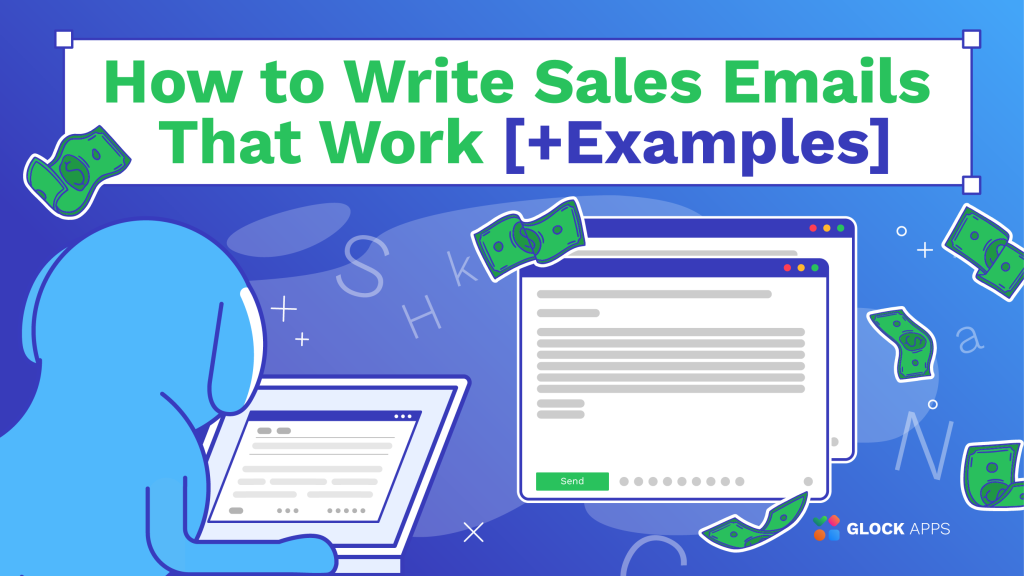How to Write Sales Emails That Work [+Examples]
Estimated reading time: 6 minutes

Table of contents
Today, an average email user usually gets 150-200 emails a day. People swiftly go through the emails, focusing on the ones that seem important and disregarding the others until they are overtaken by a new batch that arrives. With two hundred emails a day on average, only about half of them receive attention. The other half remains unseen or goes to trash, sometimes unfairly.
From the sender’s viewpoint, after hours spent on creating an ideal email, it is very frustrating when it is not opened. This emphasizes how important it is to become an expert at creating sales emails that actually result in conversions.
Writing sales emails could come naturally to those in the sales industry. Writing an effective sales email, however, is a different story. Fortunately, creating a sales email that converts isn’t that difficult; all it takes is knowing what to write about and how to organize it.
Below we’ll go into the fundamentals of writing persuasive sales emails, examine important elements that improve sales emails, give strong examples, and share insightful information. Gaining knowledge in this area will transform your commercial endeavors and significantly increase your sales potential.
Essential Elements of the Best Sales Emails
An effective sales email should be structured following the unified format. Even though the contents of each email may differ, all of your sales email templates should generally have these five elements:
- Captivating subject line;
- Attention-grabbing opening text;
- Straightforward body;
- Clear call-to-action;
- Well written signature.
Captivating Subject Line
It’s the first thing the recipient sees when they look at the emails in the inbox. No matter how long your sales email copy is, your Subject line must entice people to read on.
It’s crucial to become an expert at creating attention-grabbing subject lines. It makes sure that people open your emails – the first step to further reading and interaction – as opposed to just scanning them and going on.
Attention-Grabbing Opening Text
When a recipient has been successfully drawn in by an excellent Subject line, the next challenge is to keep them reading. You need a strong starting sentence to accomplish this.
Start your email with something pertinent and customized; stay away from general terms that could imply that it was sent by mass production. Including details about the recipient’s role or organization can effectively personalize the email, even if you don’t know them well.
If you don’t have any personal information to provide, you may start with an interesting fact or statistic to get them interested. The idea is to engage the receiver with something valuable rather than seeming like a generic sales pitch.
Straightforward Body
The body of the sales email actually explains why you are contacting the person. As it’s the longest part, it shouldn’t be boring. Fill the body with interesting and educational material. Try to keep it brief but make sure you cover all the important information. Express your offer clearly and provide examples of how it will help achieve the goals or serve the interests of the recipient.
Clear Call-to-Action
The call to action, or CTA, directs the reader’s next actions. It may take the form of an interactive button or a straight question that sparks additional conversation. Here are a few instances of successful CTAs:
Are you available tomorrow at [specific times] to discuss further?
Are you eager to find out more? Contact me at [your phone number].
Could we schedule a follow-up discussion for next Monday at [specific times]?
Book a consultation now
Find out more about our [product/service name]
Each of the mentioned call-to-actions entices the reader to interact by offering precise directions or questions. A clear call-to-action in your sales email greatly increases the chance of a response.
Well Written Signature
Lastly, your sales email should end with your signature line. It should be the proper amount of personal information. Remain clear and short. Closing phrases to use are “Best,” “Sincerely,” “Regards,” and “Speak soon.”
Make sure your signature contains your organization name, contact information, and a link to your website. If you have accounts with social networks, include them in the signature. This gives the receivers multiple ways to interact with you based on their preferences.
Effective Sales Email Examples
Now that you have a better idea of the crucial elements of an effective sales email, let’s consider a few examples of convincing sales emails to help you grasp good writing strategies.
Sales Email Example #1
Hello [First Name],
I hope this message finds you well.
I've been admiring the work of [Business Name] and its efforts in enhancing email marketing efficiency, particularly in writing persuasive sales emails. I've brainstormed several strategies that I believe could significantly elevate your clients' success rates in closing deals.
Could we perhaps schedule a call on [Day] at [Time] to discuss these ideas?
Thank you for considering this opportunity, [First Name]. I’m eagerly awaiting your response.
Best regards,
[Your Name]
[Your Contact Information]
Sales Email Example #2
Hello [First Name],
My name is [Your Name] and I represent GlockApps, a leading email deliverability testing and monitoring service. With GlockApps, businesses gain the tools to maximize their email marketing efforts ensuring their important transactional messages and well crafted sales emails reach the clients’ inboxes.
I'm confident that integrating GlockApps into [Business Name]'s workflow would yield numerous benefits.
Eager to explore further? If you're available, we could discuss how GlockApps can empower [Business Name] during a call tomorrow at either [Time 1] or [Time 2].Best regards,
[Your Name]
[Your Contact Information]
More Tips on How to Write a Sales Email
The following additional tips can increase the probability for your sales email being noticed and read, thus making your marketing efforts more effective:
1. Think about Sending Time
It’s critical to choose the ideal moment to send your sales email. If an email is sent at the wrong time, it could be ignored, even if it is extremely persuasive. It could take some trial and error to find the best sending times.
Keep in mind the differences in time zones when communicating with recipients who are located in different areas. If you send an essential email at 5 PM on your schedule and it’s 8 PM on theirs, you might not get the response you want. To guarantee that your communication reaches its recipients at the proper hour, always account for time zone differences.
2. Send Follow-Ups
Do not worry if your recipient does not reply right away. It happens frequently, which is why sending follow-up emails is crucial. One more email could be all it takes to close the deal. Make sure that the personalization and value of your follow-up communications match those of your first correspondence.
3. Monitor Email Metrics
You may send hundreds of emails every day, but you’re operating blindly if you don’t monitor their effectiveness. To determine efficacy and identify areas for improvement, monitoring is crucial.
Monitoring the effectiveness of your sales emails gives you access to important data such as open, forward, bounce, clickthrough, and conversion rates. By ensuring that your emails are in line with your goals, these metrics will help you optimize your email marketing plan.
4. Test Email Deliverability
The effectiveness of sales emails depends on the writer’s ability to generate a compelling copy and on the sender’s ability to get it delivered in the inboxes of the potential clients. After all, closing business becomes an uphill battle if the receivers don’t see your emails.
The good news is that with thorough testing and monitoring, you can improve your Inbox placement rates. You can improve your strategy by trying different things, testing different sales email copies, Subject lines, and even email service providers, thus progressively raising your open rates and conversions until you’re happy with the outcomes.



